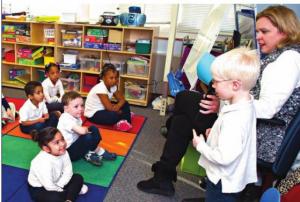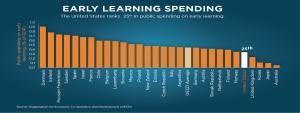
WASHINGTON (AP) – Minority children, who will make up the majority future workforce, need quality early learning and preschool programs. This presents a great challenge for the nation because most minority children are born in poverty and do not have access to high quality early learning programs.
The overrepresentation of minority children among the poor is not new. What is new is that minority children will, in the not-too-distant future, form the core of the nation's workforce, and their taxes will be depended on to keep solvent entitlement programs for the elderly.
Based on where things stand for nonwhite children today, it's not hard to make some educated guesses about what the future holds for the youngest of America's children who already are a majority of their age group, said Sam Fulwood III, a senior fellow at the Center for American Progress. The recent recession worsened conditions for many children, but minorities were hard hit and are having more difficulty recovering.
The Pew Charitable Trusts found that, from 1999 to 2009, 23% of black families and 27% of Hispanic families experienced long-term unemployment, compared with 11% of white families. Pew Research Center, a subsidiary, found that the median wealth of white households is 20 times that of black households and 18 times that of Hispanic households. That means more minority families end up in poor neighborhoods with underperforming school systems, leading to lower graduation rates and lower lifetime earnings, said Leonard Greenhalgh, a professor of management at Tuck School of Business at Dartmouth College in New Hampshire.
"You are looking at the future workforce of the United States – what we need to be competitive against rival economies such as India and China, and we are not educating the largest, fastest growing percentage of the U.S. workforce, so as a nation we lose competitive advantage," Greenhalgh said. It all starts with preschool, where overall enrollment has been increasing but Hispanic children are less likely to be included. Of Hispanic children ages 3 to 5 in the U.S., 13.4% were enrolled in full-day public or private nursery school in 2011, according to data from the National Center for Education Statistics. That compares with 25.8% of black children enrolled in full-day preschool and 18.1% of white children. But already, Hispanics are one-quarter of students enrolled in public schools.

President Barack Obama has proposed raising cigarette taxes to help pay for preschools. He has proposed a program to entice states to expand preschool programs to reach families with incomes up to twice the poverty line, and to require full-day kindergarten. But the partisan political showdown over government spending and raising taxes has led to across-the-board federal spending cuts and stalls in other legislation that may delay those proposals.
Sheila Smith, early childhood director at Columbia University's National Center for Children in Poverty, points to years of research that show kindergarteners perform better if they received high-quality early care, and if teachers used specific strategies aimed at developing behavior and language and math skills. "If you have minority children from low-income families in very enriched preschool settings ... we see they make very big gains," Smith said. "But how many classrooms are very enriched to the point that we see kids making these very big gains? Not nearly enough."
Compounding the issue, experts say, is immigration status. About 4.5 million children of all races born in the U.S. have at least one parent not legally in the U.S., according to the Pew Hispanic Center. More than two-thirds of impoverished Latino children are the children of at least one immigrant parent, the center reported. Latino and Asian immigrants over past two decades are driving a significant portion of the demographic change, and ensuring their children can succeed is critical, said Brookings Institution demographer William Frey.
"They're the future of our labor force. They're the future of our economy," Frey said. "They're the people who white baby boomers are going to have to depend on for their Social Security, for their Medicare and just for a productive economy to keep all of us going in the future."
